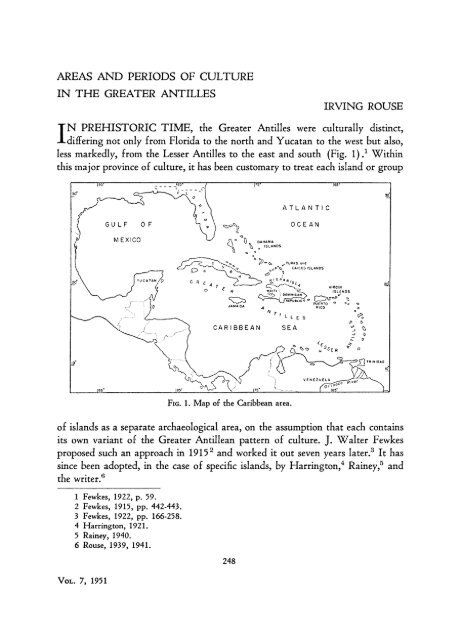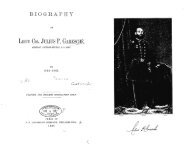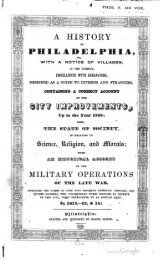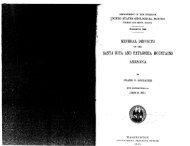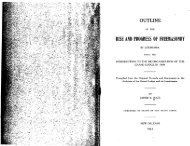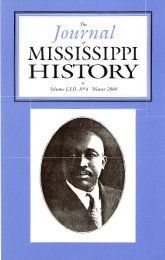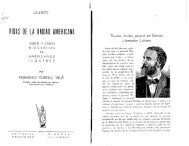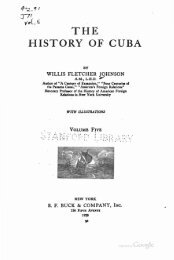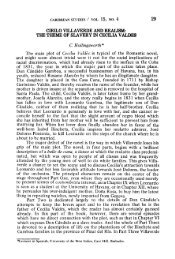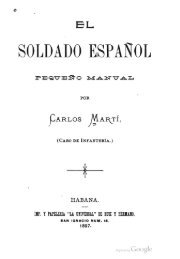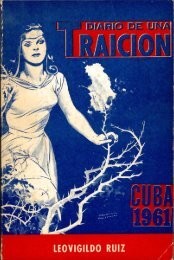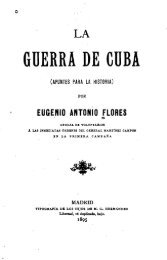Areas and Periods of Culture in the Greater Antilles
Areas and Periods of Culture in the Greater Antilles
Areas and Periods of Culture in the Greater Antilles
You also want an ePaper? Increase the reach of your titles
YUMPU automatically turns print PDFs into web optimized ePapers that Google loves.
AREAS AND PERIODS OF CULTURE<br />
IN THE GREATER ANTILLES<br />
IRVING ROUSE<br />
IN PREHISTORIC TIME, <strong>the</strong> <strong>Greater</strong> <strong>Antilles</strong> were culturally dist<strong>in</strong>ct,<br />
differ<strong>in</strong>g not only from Florida to <strong>the</strong> north <strong>and</strong> Yucatan to <strong>the</strong> west but also,<br />
less markedly, from <strong>the</strong> Lesser <strong>Antilles</strong> to <strong>the</strong> east <strong>and</strong> south (Fig. 1).1 With<strong>in</strong><br />
this major prov<strong>in</strong>ce <strong>of</strong> culture, it has been customary to treat each isl<strong>and</strong> or group<br />
FIG. 1. Map <strong>of</strong> <strong>the</strong> Caribbean area.<br />
<strong>of</strong> isl<strong>and</strong>s as a separate archaeological area, on <strong>the</strong> assumption that each conta<strong>in</strong>s<br />
its own variant <strong>of</strong> <strong>the</strong> <strong>Greater</strong> Antillean pattern <strong>of</strong> culture. J. Walter Fewkes<br />
proposed such an approach <strong>in</strong> 19152 <strong>and</strong> worked it out seven years later.3 It has<br />
s<strong>in</strong>ce been adopted, <strong>in</strong> <strong>the</strong> case <strong>of</strong> specific isl<strong>and</strong>s, by Harr<strong>in</strong>gton,4 Ra<strong>in</strong>ey,5 <strong>and</strong><br />
<strong>the</strong> writer.6<br />
1 Fewkes, 1922, p. 59.<br />
2 Fewkes, 1915, pp. 442-443.<br />
3 Fewkes, 1922, pp. 166-258.<br />
4 Harr<strong>in</strong>gton, 1921.<br />
5 Ra<strong>in</strong>ey, 1940.<br />
6 Rouse, 1939, 1941.<br />
VOL. 7, 1951<br />
248
CULTURE IN THE GREATER ANTILLES<br />
Recent work <strong>in</strong> connection with <strong>the</strong> Caribbean Anthropological Program <strong>of</strong><br />
Yale University <strong>in</strong>dicates that this approach is too limited. As <strong>the</strong> dist<strong>in</strong>ction<br />
between <strong>the</strong> two major groups <strong>of</strong> Indians <strong>in</strong> <strong>the</strong> <strong>Greater</strong> <strong>Antilles</strong>-<strong>the</strong> Ciboney<br />
<strong>and</strong> Arawak-has sharpened, it has become apparent that <strong>the</strong> areas <strong>of</strong> <strong>the</strong>ir<br />
respective cultures differ fundamentally, with only <strong>the</strong> Ciboney areas correspond<strong>in</strong>g<br />
to Fewkes' conception <strong>of</strong> distribution by isl<strong>and</strong>s. The Arawak areas cut across<br />
<strong>the</strong> isl<strong>and</strong>s <strong>in</strong>stead <strong>of</strong> enclos<strong>in</strong>g <strong>the</strong>m <strong>and</strong>, moreover, are sharply dist<strong>in</strong>ct dur<strong>in</strong>g<br />
only <strong>the</strong> second <strong>of</strong> <strong>the</strong> three periods <strong>of</strong> Arawak occupation. It is <strong>the</strong> purpose <strong>of</strong><br />
<strong>the</strong> present article to illustrate <strong>the</strong>se po<strong>in</strong>ts <strong>and</strong> to suggest explanations for <strong>the</strong>m.<br />
INDIANS OF THE GREATER ANTILLES<br />
Columbus encountered three groups <strong>of</strong> natives <strong>in</strong> <strong>the</strong> West Indies: Ciboney,<br />
Arawak, <strong>and</strong> Carib. The first are poorly known, for <strong>the</strong>y were restricted <strong>in</strong><br />
colonial time to <strong>the</strong> western tip <strong>of</strong> Cuba, to <strong>the</strong> keys <strong>of</strong>f <strong>the</strong> nor<strong>the</strong>rn <strong>and</strong> sou<strong>the</strong>rn<br />
coasts <strong>of</strong> that isl<strong>and</strong>, <strong>and</strong> to <strong>the</strong> southwestern corner <strong>of</strong> Hispaniola, regions which<br />
<strong>the</strong> Spaniards rarely penetrated before <strong>the</strong> Indians became ext<strong>in</strong>ct. The Ciboney<br />
are said to have lived <strong>in</strong> caves or camps; obta<strong>in</strong>ed <strong>the</strong>ir food by hunt<strong>in</strong>g, fish<strong>in</strong>g,<br />
<strong>and</strong> ga<strong>the</strong>r<strong>in</strong>g ra<strong>the</strong>r than agriculture; <strong>and</strong> to have had a relatively simple social<br />
<strong>and</strong> religious life. S<strong>in</strong>ce Columbus' Arawak <strong>in</strong>terpreters could not underst<strong>and</strong><br />
<strong>the</strong>ir language, it is assumed to have been non-Arawak, although it might <strong>in</strong>stead<br />
have been a different Arawak dialect.7<br />
The Arawak occupied most <strong>of</strong> <strong>the</strong> rest <strong>of</strong> <strong>the</strong> <strong>Greater</strong> <strong>Antilles</strong> at <strong>the</strong> time <strong>of</strong><br />
historic contact. They were agricultural, pottery-mak<strong>in</strong>g Indians <strong>and</strong> lived <strong>in</strong><br />
permanent villages ra<strong>the</strong>r than camps. Accord<strong>in</strong>g to <strong>the</strong> Spanish sources, <strong>the</strong>y<br />
had a hereditary aristocracy; elaborate songs, dances, <strong>and</strong> ceremonies; <strong>and</strong> an<br />
emphasis upon religion, center<strong>in</strong>g <strong>in</strong> <strong>the</strong> worship <strong>of</strong> spirits known as zemis. They<br />
were peaceable <strong>and</strong> did not practice cannibalism.8<br />
By contrast, <strong>the</strong> Carib were cannibals <strong>and</strong> emphasized warfare. They spoke a<br />
language different from that <strong>of</strong> <strong>the</strong> Arawak; may have relied more upon fish<strong>in</strong>g<br />
than upon agriculture; lived <strong>in</strong> semi-permanent villages; had less <strong>of</strong> an <strong>in</strong>terest<br />
<strong>in</strong> religion; <strong>and</strong> chose <strong>the</strong>ir leaders for <strong>the</strong>ir prowess <strong>in</strong> fight<strong>in</strong>g ra<strong>the</strong>r than on<br />
<strong>the</strong> basis <strong>of</strong> <strong>in</strong>heritance. They centered <strong>in</strong> <strong>the</strong> Lesser <strong>Antilles</strong>, <strong>and</strong>, by <strong>the</strong> time<br />
<strong>of</strong> Columbus, had established advanced bases <strong>in</strong> <strong>the</strong> Virg<strong>in</strong> Isl<strong>and</strong>s <strong>and</strong> on<br />
7 Garcia Valdes, 1948. Some Cuban anthropologists, e.g., Cosculluela (1946), have substituted<br />
<strong>the</strong> term "Guanajatabey" for "Ciboney" on <strong>the</strong> assumption that <strong>the</strong> latter more<br />
properly applies to an Arawak sub-group. Alegria (1948) proposes <strong>the</strong> use <strong>of</strong> an archaeological<br />
term, "Archaic."<br />
8 Roth, 1887; Krieger, 1930; Rouse, 1948, pp. 522-539.<br />
249
250<br />
SOUTHWESTERN JOURNAL OF ANTHROPOLOGY<br />
Vieques, an islet <strong>of</strong>f <strong>the</strong> east coast <strong>of</strong> Puerto Rico, whence <strong>the</strong>y conducted periodic<br />
raids on <strong>the</strong> Arawak <strong>of</strong> <strong>the</strong> larger isl<strong>and</strong>s, far<strong>the</strong>r west.9<br />
It is generally agreed that <strong>the</strong> Ciboney were <strong>the</strong> first to settle <strong>the</strong> West Indies,<br />
but whe<strong>the</strong>r <strong>the</strong>y orig<strong>in</strong>ally came from North America, as seems likely to us, is<br />
still a matter for dispute.10 The Arawak arrived next, migrat<strong>in</strong>g from South<br />
America by way <strong>of</strong> <strong>the</strong> Lesser <strong>Antilles</strong> <strong>and</strong> driv<strong>in</strong>g <strong>the</strong> Ciboney back <strong>in</strong>to <strong>the</strong><br />
peripheral positions <strong>in</strong> which <strong>the</strong>y were found by <strong>the</strong> Spaniards.11 The Carib were<br />
<strong>the</strong> last to move <strong>in</strong>, aga<strong>in</strong> from <strong>the</strong> South American ma<strong>in</strong>l<strong>and</strong>. To judge from <strong>the</strong><br />
Indian traditions, <strong>the</strong>y took over <strong>the</strong> Lesser <strong>Antilles</strong> from <strong>the</strong> Arawak shortly<br />
before <strong>the</strong> arrival <strong>of</strong> Columbus.12<br />
SPACE AND TIME SCALES<br />
For <strong>the</strong> purpose <strong>of</strong> survey<strong>in</strong>g <strong>the</strong> archaeology, it will be convenient to divide<br />
<strong>the</strong> <strong>Greater</strong> <strong>Antilles</strong> <strong>in</strong>to a series <strong>of</strong> geographical units, which are represented by<br />
<strong>the</strong> vertical columns <strong>in</strong> <strong>the</strong> body <strong>of</strong> <strong>the</strong> accompany<strong>in</strong>g chart (Fig. 2). From west<br />
to east, <strong>the</strong>se <strong>in</strong>clude: (1) western Cuba, (2) central Cuba, (3) eastern Cuba,<br />
(4) Jamaica, (5) <strong>the</strong> Turks <strong>and</strong> Caicos Isl<strong>and</strong>s, (6) Haiti, (7) <strong>the</strong> Dom<strong>in</strong>ican<br />
Republic, (8) <strong>the</strong> western half <strong>of</strong> Puerto Rico, (9) eastern Puerto Rico, <strong>and</strong><br />
(10) <strong>the</strong> Virg<strong>in</strong> Isl<strong>and</strong>s. The Bahamas colony, north <strong>of</strong> Cuba <strong>and</strong> northwest <strong>of</strong><br />
<strong>the</strong> Turks <strong>and</strong> Caicos Isl<strong>and</strong>s, has been omitted because so little is known <strong>of</strong> its<br />
archaeology.<br />
These particular units have been selected because <strong>the</strong>y are <strong>the</strong> largest regions<br />
which appear to have been geographically homogeneous <strong>in</strong> culture dur<strong>in</strong>g each<br />
successive period <strong>of</strong> prehistory. Never<strong>the</strong>less, <strong>the</strong>y should not be considered<br />
culture areas, but, ra<strong>the</strong>r, segments <strong>the</strong>re<strong>of</strong>. In order to form areas, we have had<br />
to proceed period by period <strong>and</strong> to comb<strong>in</strong>e those units which are similar <strong>in</strong><br />
culture. As will be shown, <strong>the</strong> comb<strong>in</strong>ations vary from period to period.<br />
Seven arbitrary periods <strong>of</strong> time, comparable to <strong>the</strong> units <strong>of</strong> space, have been<br />
recognized <strong>in</strong> <strong>the</strong> <strong>Greater</strong> <strong>Antilles</strong>. They comprise <strong>the</strong> horizontal columns <strong>in</strong><br />
Figure 2, where <strong>the</strong>y are numbered I, IIa, IIb, IIIa, IIIb, IVa, <strong>and</strong> IVb. The<br />
9 Ober, 1895; Joyce, 1916; Rouse, 1948, pp. 547-565; Taylor, 1949. The last disagrees<br />
with several <strong>of</strong> <strong>the</strong> above statements, particularly that <strong>the</strong> Carib relied so much on sea food.<br />
10 Rouse, 1949. For <strong>the</strong> alternative <strong>the</strong>ory, that <strong>the</strong> Ciboney migrated from South America,<br />
see Harr<strong>in</strong>gton (1921, vol. 2, pp. 424-426) <strong>and</strong> Herrera Fritot (1943, p. 268).<br />
11 Osgood, 1942; Rouise, 1947b.<br />
12 Gower, 1927; Loven, 1935, pp. 51-53. Disagree<strong>in</strong>g with <strong>the</strong> latter's <strong>in</strong>terpretation <strong>of</strong> <strong>the</strong><br />
documentary evidence, Taylor (1949, pp. 381-382) doubts <strong>the</strong> recency <strong>of</strong> <strong>the</strong> Carib migration.<br />
However, it is substantiated for <strong>the</strong> areas under consideration here by <strong>the</strong> archaeological sequences<br />
discussed below.
CULTURE IN THE GREATER ANTILLES<br />
251<br />
evidence on which <strong>the</strong>se temporal units are based has been presented elsewhere;13<br />
suffice it to say here that <strong>the</strong>y are <strong>the</strong> result <strong>of</strong> stratigraphic analysis <strong>of</strong> refuse<br />
deposits, comb<strong>in</strong>ed with cross-dat<strong>in</strong>g <strong>in</strong> terms <strong>of</strong> trade objects. Like <strong>the</strong> units<br />
<strong>of</strong> space, <strong>the</strong>y are not entirely dist<strong>in</strong>ct <strong>in</strong> culture or style: <strong>in</strong> many cases it is<br />
necessary to comb<strong>in</strong>e two or more <strong>of</strong> <strong>the</strong>m <strong>in</strong> order to arrive at cultural or stylistic<br />
periods, <strong>and</strong> <strong>the</strong> comb<strong>in</strong>ations vary from region to region.<br />
I<br />
Western Central Esern<br />
Turks <strong>and</strong><br />
Western Eastern<br />
Leriod | Cua to Cua e Jaomica Coicos i Dom<strong>in</strong>ican<br />
Haiti ts<br />
Puerto Puerto Virg<strong>in</strong> Period<br />
cuba Cuba Cuba Islonds Republic Rico Rico Isl<strong>and</strong>s<br />
IVb ? IVb<br />
PUEBLO CARRIER-CARRIER BOCA CAPA CAPAESPERANZA<br />
ESPERAN.A? ? -....<br />
VIEJO LIKE CHICA<br />
ESPER-<br />
IVa BANI-LIKE ANZA ' IVo<br />
LIKE<br />
IlIb BANI<br />
OSTIONES- SANTA Illb<br />
LIKE<br />
ELENA SANTA<br />
MEILLAC ELENA- m --<br />
OSTIONES LIKE<br />
So(Anodel-<br />
Illo sites) (Shell sites) g o<br />
lib<br />
lib<br />
CAYO REDONDO<br />
F<br />
CUEVAS<strong>and</strong><br />
CUEVAS LIKE<br />
GUAYABO BLANCO ? CABARET (Roilrood (Crab sites) (Coral Bay-<br />
Ila <strong>and</strong> Cove, etc.) Longford lao<br />
___<br />
Ia<br />
~~~~~~COURI<br />
~sites)<br />
2 ?<br />
(Coroso sites)<br />
(Krum Bay<br />
site)<br />
FIG. 2. Preceramic cultures <strong>and</strong> ceramic styles <strong>in</strong> <strong>the</strong> <strong>Greater</strong> <strong>Antilles</strong>.<br />
No adequate way has yet been found to convert <strong>the</strong> units <strong>of</strong> time <strong>in</strong>to <strong>the</strong><br />
Christian calendar. Some <strong>in</strong>dication <strong>of</strong> <strong>the</strong>ir duration, however, may be obta<strong>in</strong>ed<br />
from <strong>the</strong> follow<strong>in</strong>g estimates, obta<strong>in</strong>ed by apply<strong>in</strong>g <strong>the</strong> rate <strong>of</strong> refuse accumulation<br />
<strong>in</strong> Puerto Rico dur<strong>in</strong>g <strong>the</strong> historic period (IVb) to <strong>the</strong> average depth <strong>of</strong><br />
<strong>the</strong> deposits on that isl<strong>and</strong> assigned to each <strong>of</strong> <strong>the</strong> prehistoric periods:<br />
14<br />
Period IVb<br />
Period IVa<br />
Period IIIb<br />
Period IIIa<br />
Period IIb<br />
Period IIa<br />
Period I<br />
1509-1584 AD<br />
1437-1509 AD<br />
1317-1437 AD<br />
1193-1317 AD<br />
1089-1193 AD<br />
929-1089 AD<br />
-929 AD<br />
13 Ra<strong>in</strong>ey, 1940; Rouse, 1939, 1941, MSa.<br />
14 Rouse, MSa. S<strong>in</strong>ce <strong>the</strong>se calculations project <strong>the</strong> historic rate <strong>of</strong> accumulation back <strong>in</strong><br />
time, <strong>the</strong>y are probably more reliable for <strong>the</strong> later than for <strong>the</strong> earlier periods.
252<br />
SOUTHWESTERN<br />
JOURNAL OF ANTHROPOLOGY<br />
PHASES AND STYLES<br />
The spatial <strong>and</strong> temporal units just outl<strong>in</strong>ed provide a scale upon which to<br />
lay out <strong>the</strong> archaeological rema<strong>in</strong>s <strong>of</strong> <strong>the</strong> <strong>Greater</strong> <strong>Antilles</strong>, as <strong>in</strong> Figure 2. The<br />
solid black l<strong>in</strong>e runn<strong>in</strong>g diagonally across <strong>the</strong> middle <strong>of</strong> this chart marks <strong>the</strong><br />
appearance <strong>of</strong> ceramics <strong>and</strong> agriculture; all <strong>the</strong> rema<strong>in</strong>s <strong>in</strong>dicated below this l<strong>in</strong>e<br />
lack pottery <strong>and</strong> agricultural utensils, while those above <strong>the</strong> l<strong>in</strong>e have both.<br />
The names below <strong>the</strong> solid black l<strong>in</strong>e refer to cultural phases, i.e. to complexes<br />
<strong>of</strong> type <strong>of</strong> artifacts which recur from site to site. The names above <strong>the</strong> l<strong>in</strong>e refer<br />
<strong>in</strong>stead to ceramic styles, i.e. to similarly recurr<strong>in</strong>g complexes <strong>of</strong> pottery traits.<br />
This difference <strong>of</strong> treatment is a concession to <strong>the</strong> nature <strong>of</strong> <strong>the</strong> data: <strong>in</strong> <strong>the</strong> sites<br />
represented below <strong>the</strong> l<strong>in</strong>e, implements are practically our sole source <strong>of</strong> <strong>in</strong>formation,<br />
while <strong>in</strong> <strong>the</strong> sites above <strong>the</strong> l<strong>in</strong>e, over n<strong>in</strong>ety-five percent <strong>of</strong> <strong>the</strong> artifacts<br />
found are ceramic. S<strong>in</strong>ce what is known <strong>of</strong> <strong>the</strong> burials, ceremonial structures, <strong>and</strong><br />
stone, bone, <strong>and</strong> shell artifacts associated with each style <strong>in</strong>dicates that <strong>the</strong>y<br />
varied <strong>in</strong> correlation with <strong>the</strong> pottery,15 it is thought that <strong>the</strong> shift from nonceramic<br />
phases to ceramic styles will not affect our conclusions.<br />
As is customary, we assume that all <strong>the</strong> phases below <strong>the</strong> solid black l<strong>in</strong>e are<br />
Ciboney, although this identification cannot be proven for lack <strong>of</strong> a detailed<br />
chronology <strong>of</strong> <strong>the</strong> non-ceramic phases <strong>and</strong> is rejected by some Cuban archaeologists.l6<br />
Similarly, we consider all <strong>the</strong> styles above <strong>the</strong> l<strong>in</strong>e to be Arawak. Here we<br />
are on firmer ground, s<strong>in</strong>ce stratigraphic studies <strong>in</strong> Puerto Rico <strong>in</strong>dicate a cont<strong>in</strong>uity<br />
<strong>of</strong> stylistic <strong>and</strong> cultural developments through <strong>Periods</strong> II, III, <strong>and</strong> IV.17<br />
It is not possible to correlate any <strong>of</strong> <strong>the</strong> rema<strong>in</strong>s so far discovered <strong>in</strong> <strong>the</strong><br />
<strong>Greater</strong> <strong>Antilles</strong> with <strong>the</strong> third ethnic group, <strong>the</strong> Carib. To judge from <strong>the</strong><br />
documentary evidence, Carib rema<strong>in</strong>s should eventually be found <strong>in</strong> <strong>the</strong> Virg<strong>in</strong><br />
Isl<strong>and</strong>s <strong>and</strong> on <strong>the</strong> islets <strong>of</strong>f <strong>the</strong> east coast <strong>of</strong> Puerto Rico, dat<strong>in</strong>g from Period<br />
IVb, at least. For <strong>the</strong> sake <strong>of</strong> completeness, <strong>the</strong>refore, we have added a dashed<br />
black l<strong>in</strong>e to <strong>the</strong> chart to mark <strong>of</strong>f <strong>the</strong> section which is potentially Carib, even<br />
though this will not figure <strong>in</strong> <strong>the</strong> present discussion <strong>of</strong> <strong>the</strong> archaeological rema<strong>in</strong>s.<br />
15 Cf., for example, Rouse (1948, pp. 510-517), where <strong>the</strong> Arawak material is presented<br />
<strong>in</strong> terms <strong>of</strong> cultural phases ra<strong>the</strong>r than ceramic styles.<br />
16 E.g., Pichardo Moya (1945), where it is assumed that <strong>the</strong> less advanced non-ceramic<br />
cultures, such as Guyabo Blanco, are pre-Ciboney.<br />
17 Rouse, MSa. Ra<strong>in</strong>ey (1940) concluded that <strong>the</strong>re was a break <strong>in</strong> <strong>the</strong> cultural sequence<br />
at <strong>the</strong> close <strong>of</strong> Period IIa, but this was subsequently filled by <strong>the</strong> discovery <strong>of</strong> rema<strong>in</strong>s dat<strong>in</strong>g<br />
from Period IIb.
CULTURE IN THE GREATER ANTILLES<br />
253<br />
CIBONEY PHASES<br />
In order to exam<strong>in</strong>e <strong>the</strong> geographical variation <strong>in</strong> Ciboney culture, <strong>and</strong> <strong>the</strong>reby<br />
provide a basis for dist<strong>in</strong>guish<strong>in</strong>g areas with<strong>in</strong> it, we shall discuss briefly each <strong>of</strong><br />
<strong>the</strong> non-ceramic phases, beg<strong>in</strong>n<strong>in</strong>g <strong>in</strong> <strong>the</strong> west <strong>and</strong> work<strong>in</strong>g eastward. Two phases<br />
are recognized <strong>in</strong> Cuba: Guayabo Blanco <strong>and</strong> Cayo Redondo.l8 As <strong>in</strong>dicated <strong>in</strong><br />
Figure 2, both are restricted to that isl<strong>and</strong> <strong>and</strong> apparently extend throughout it,<br />
but <strong>the</strong>ir relative chronological position is unknown.<br />
The Guaybo Blanco phase is represented by small shell deposits, ei<strong>the</strong>r <strong>in</strong><br />
caves or <strong>in</strong> <strong>the</strong> open, especially <strong>in</strong> swamp areas. Its artifacts <strong>in</strong>clude gouges,<br />
plates, <strong>and</strong> cups, made from <strong>the</strong> outer whorl <strong>of</strong> <strong>the</strong> conch (Strombus sp.); deeper<br />
vessels, consist<strong>in</strong>g <strong>of</strong> conch shells from which <strong>the</strong> columella <strong>and</strong> <strong>in</strong>ner whorls have<br />
been removed; unworked or slightly retouched flakes <strong>of</strong> fl<strong>in</strong>t; <strong>and</strong> crude hammerstones.19<br />
Because <strong>of</strong> <strong>the</strong> absence <strong>of</strong> stone gr<strong>in</strong>d<strong>in</strong>g, this phase has been termed<br />
"paleolithic,"20 although <strong>the</strong> emphasis on shellwork is atypical <strong>of</strong> that stage <strong>of</strong><br />
cultural development.<br />
The Cayo Redondo sites are similar. Gouges, plates, <strong>and</strong> cups <strong>of</strong> shell are<br />
aga<strong>in</strong> found, but <strong>the</strong> deep shell vessel is miss<strong>in</strong>g. In addition to hammerstones<br />
<strong>and</strong> fl<strong>in</strong>t flakes, <strong>the</strong>re are gr<strong>in</strong>ders, dishes, balls, <strong>and</strong> peg-shaped ceremonial<br />
objects known as gladiolitos, all <strong>of</strong> which have been ground <strong>of</strong> stone. These are<br />
said to give <strong>the</strong> phase a "mesolithic" cast.21<br />
Two parallel phases <strong>of</strong> Ciboney culture have been dist<strong>in</strong>guished <strong>in</strong> Haiti:<br />
Cabaret <strong>and</strong> Couri. These also appear to have an overlapp<strong>in</strong>g distribution (Fig.<br />
2). It is not known whe<strong>the</strong>r <strong>the</strong>y extend <strong>in</strong>to <strong>the</strong> Dom<strong>in</strong>ican Republic.<br />
The small Cabaret shell heaps have so far yielded only irregularly shaped,<br />
unworked or slightly retouched flakes <strong>of</strong> fl<strong>in</strong>t, comparable to those <strong>in</strong> Cuba,<br />
toge<strong>the</strong>r with <strong>the</strong> cores from which <strong>the</strong>se flakes were struck. The shell work so<br />
characteristic <strong>of</strong> Cuba is miss<strong>in</strong>g.22<br />
The Couri shell deposits are <strong>the</strong> richest <strong>of</strong> all Ciboney sites. They are characterized<br />
by daggers, knives, <strong>and</strong> scrapers <strong>of</strong> fl<strong>in</strong>t, all made by f<strong>in</strong>ely rechipp<strong>in</strong>g<br />
<strong>the</strong> edges <strong>of</strong> large lamellar flakes, which contrast strongly with <strong>the</strong> smaller, more<br />
irregular Cabaret flakes. Ground-stone work is well developed; <strong>the</strong> types <strong>in</strong>clude<br />
dishes, s<strong>in</strong>gle- <strong>and</strong> double-bitted axes, balls, beads, <strong>and</strong> gladiolitos, as well as<br />
18 As already noted, some Cubans use o<strong>the</strong>r terms to refer to <strong>the</strong>se phases (e.g., Cosculluela,<br />
1946).<br />
19 Cosculluela, 1946, pp. 11-12.<br />
20 Ortiz, 1943, p. 137.<br />
21 Osgood, 1942; Ortiz, 1943, p. 137.<br />
22 Rouma<strong>in</strong>, 1942; Bastien, 1944.
254<br />
SOUTHWESTERN JOURNAL OF ANTHROPOLOGY<br />
mortars <strong>and</strong> pestles, <strong>and</strong> mill<strong>in</strong>g <strong>and</strong> polish<strong>in</strong>g stones. A chisel <strong>and</strong> an elaborately<br />
carved pendant are <strong>the</strong> only objects <strong>of</strong> shell yet found. It is noteworthy that <strong>the</strong><br />
shell pendant <strong>and</strong> an ax, pestle, <strong>and</strong> two fragmentary dishes <strong>of</strong> stone are decorated<br />
with rectil<strong>in</strong>ear <strong>in</strong>cised designs, which foreshadow some <strong>of</strong> <strong>the</strong> designs <strong>of</strong> <strong>the</strong><br />
Meillac <strong>and</strong> Bani ceramic styles discussed below.23<br />
Non-ceramic strata have been found underly<strong>in</strong>g ceramic refuse <strong>in</strong> two caves<br />
<strong>of</strong> eastern Santo Dom<strong>in</strong>go24 <strong>and</strong> one <strong>in</strong> Puerto Rico,25 but <strong>the</strong>ir contents are not<br />
known. Puerto Rico <strong>and</strong> <strong>the</strong> Virg<strong>in</strong> Isl<strong>and</strong>s also conta<strong>in</strong> a series <strong>of</strong> non-ceramic<br />
shell deposits, <strong>the</strong> cultural affiliations <strong>of</strong> which are uncerta<strong>in</strong>. Excavation <strong>in</strong> four<br />
<strong>of</strong> <strong>the</strong> Puerto Rican middens, <strong>of</strong> which Coroso is typical, yielded no def<strong>in</strong>itely<br />
worked artifacts but simply pieces <strong>of</strong> stone <strong>and</strong> shell which might have been<br />
used for gr<strong>in</strong>d<strong>in</strong>g, hammer<strong>in</strong>g, <strong>and</strong> splitt<strong>in</strong>g o<strong>the</strong>r materials.26 In <strong>the</strong> Virg<strong>in</strong><br />
Isl<strong>and</strong>s, <strong>the</strong> only specimens found were rectangular stone adzes, red ocher, clam<br />
shell scrapers, <strong>and</strong> a few potsherds limited to <strong>the</strong> surface.27<br />
CIBONEY PERIODS AND AREAS<br />
It will be apparent that we know little <strong>of</strong> Ciboney culture except <strong>in</strong> Cuba <strong>and</strong><br />
Haiti. Even <strong>in</strong> <strong>the</strong>se two countries, it is not yet possible to establish a Ciboney<br />
chronology, although one is tempted to assume on typological grounds that <strong>the</strong><br />
"palaeolithic" cultures <strong>in</strong> each country are earlier than <strong>the</strong> "mesolithic."<br />
Cuba <strong>and</strong> Haiti may each be said to constitute a dist<strong>in</strong>ct culture area, <strong>in</strong> that<br />
all three <strong>of</strong> <strong>the</strong> geographic units <strong>in</strong>to which we have divided <strong>the</strong> former isl<strong>and</strong><br />
have yielded <strong>the</strong> same phases <strong>and</strong> <strong>the</strong>se differ from <strong>the</strong> phases recognized <strong>in</strong><br />
Haiti (Fig. 2). The Cuban area is characterized by an emphasis upon shell<br />
artifacts-particularly <strong>the</strong> gouge-while <strong>the</strong> Haitian area has a contrast<strong>in</strong>g<br />
emphasis upon stone implements-particularly flakes <strong>and</strong> blades <strong>of</strong> fl<strong>in</strong>t. It is not<br />
known whe<strong>the</strong>r <strong>the</strong> Dom<strong>in</strong>ican Republic is l<strong>in</strong>ked with Haiti, but, to judge from<br />
<strong>the</strong> little available evidence, Puerto Rico <strong>and</strong> <strong>the</strong> Virg<strong>in</strong> Isl<strong>and</strong>s are culturally<br />
dist<strong>in</strong>ct.<br />
Future work may change <strong>the</strong> above picture, but at present it must be concluded<br />
that <strong>the</strong> distribution <strong>of</strong> Ciboney rema<strong>in</strong>s corresponds to Fewkes' conception <strong>of</strong><br />
isl<strong>and</strong> culture areas. While <strong>the</strong> various isl<strong>and</strong>s are l<strong>in</strong>ked toge<strong>the</strong>r by negative<br />
traits, such as <strong>the</strong> absence <strong>of</strong> pottery, <strong>of</strong> agricultural implements, <strong>and</strong> <strong>of</strong> ceremo-<br />
23 Ra<strong>in</strong>ey, 1941; Rouse, 1941, 1947a.<br />
24 Gabb, 1881, pp. 146-147; Krieger, 1929, pp. 5-7.<br />
25 Alegria, personal communication.<br />
26 Rouse, MSa.<br />
27 Hatt, 1924, p. 31.
CULTURE IN THE GREATER ANTILLES<br />
nial structures, each differs <strong>in</strong> its more common positive traits <strong>and</strong> <strong>the</strong>reby constitutes<br />
a separate cultural unit.<br />
ARAWAK STYLES<br />
<strong>Periods</strong> IIa <strong>and</strong> IIb. In exam<strong>in</strong><strong>in</strong>g <strong>the</strong> Arawak styles, we shall proceed by<br />
group<strong>in</strong>gs <strong>of</strong> periods <strong>and</strong> from east to west, <strong>in</strong> accordance with <strong>the</strong> time <strong>and</strong><br />
direction <strong>in</strong> which <strong>the</strong> Arawak entered <strong>the</strong> <strong>Antilles</strong>. The only style so far def<strong>in</strong>ed<br />
for <strong>Periods</strong> IIa <strong>and</strong> IIb is <strong>the</strong> Cuevas, found <strong>in</strong> <strong>the</strong> "Crab culture" sites <strong>of</strong><br />
Puerto Rico28 (Fig. 2). This pottery is technologically <strong>the</strong> best <strong>in</strong> <strong>the</strong> <strong>Greater</strong><br />
<strong>Antilles</strong>; its sherds are th<strong>in</strong>ner <strong>and</strong> f<strong>in</strong>er than most subsequent specimens, so that<br />
many r<strong>in</strong>g when struck with metal. The vessels are highly variable <strong>in</strong> shape,<br />
encompass<strong>in</strong>g almost all subsequent forms. Bowls <strong>in</strong> <strong>the</strong> shape <strong>of</strong> an <strong>in</strong>verted<br />
bell are typical; many are provided with a pair <strong>of</strong> pla<strong>in</strong>, rectangular lugs or with<br />
vertical, D-shaped strap h<strong>and</strong>les. Lugs, h<strong>and</strong>les, or a well-def<strong>in</strong>ed section <strong>of</strong> <strong>the</strong><br />
vessel surface, such as <strong>the</strong> lip or shoulder, are characteristically decorated with a<br />
red or, more rarely, black slip, or else <strong>the</strong>se areas are set <strong>of</strong>f by a high polish <strong>of</strong><br />
<strong>the</strong> surface. White-pa<strong>in</strong>ted designs, situated on <strong>the</strong> red-slipped areas, constitute a<br />
more obvious part <strong>of</strong> <strong>the</strong> decoration, but are relatively rare <strong>and</strong> are limited to<br />
Period IIa, <strong>the</strong> Cuevas pottery <strong>of</strong> Period IIb be<strong>in</strong>g decorated only with red or<br />
black pa<strong>in</strong>t.29<br />
While a comprehensive sylistic classification has not yet been worked out for<br />
<strong>the</strong> isl<strong>and</strong>s east <strong>of</strong> Puerto Rico, it is apparent that <strong>the</strong> pottery <strong>of</strong> Hatt's30 Coral<br />
Bay-Longford group <strong>of</strong> sites <strong>in</strong> <strong>the</strong> Virg<strong>in</strong> Isl<strong>and</strong>s closely parallels <strong>the</strong> Cuevas<br />
style (Fig. 2). Cuevas-like ceramic complexes have also been identified <strong>in</strong> <strong>the</strong><br />
Lesser <strong>Antilles</strong>,31 on Tr<strong>in</strong>idad,32 <strong>and</strong> at Barrancas, Venezuela, <strong>in</strong> <strong>the</strong> delta <strong>of</strong> <strong>the</strong><br />
Or<strong>in</strong>oco River.33 On <strong>the</strong> o<strong>the</strong>r h<strong>and</strong>, <strong>the</strong>re is no such pottery <strong>in</strong> <strong>the</strong> rest <strong>of</strong> <strong>the</strong><br />
<strong>Greater</strong> <strong>Antilles</strong>, west <strong>of</strong> Puerto Rico, so far as is known.<br />
In all places where a chronology is available, <strong>the</strong> Cuevas <strong>and</strong> Cuevas-like<br />
complexes occur at <strong>the</strong> beg<strong>in</strong>n<strong>in</strong>g <strong>of</strong> <strong>the</strong> ceramic sequence. Hence, <strong>the</strong>y would<br />
seem to mark <strong>the</strong> progress <strong>of</strong> <strong>the</strong> orig<strong>in</strong>al Arawak movement out from <strong>the</strong><br />
Or<strong>in</strong>oco Valley through <strong>the</strong> Lesser <strong>Antilles</strong> <strong>in</strong>to Puerto Rico. It is assumed that<br />
<strong>the</strong> Ciboney cont<strong>in</strong>ued to occupy <strong>the</strong> rest <strong>of</strong> <strong>the</strong> <strong>Greater</strong> <strong>Antilles</strong> dur<strong>in</strong>g <strong>Periods</strong><br />
IIa <strong>and</strong> IIb (Fig. 2).<br />
28 Ra<strong>in</strong>ey, 1940.<br />
29 Rouse, MSa.<br />
30 Hatt, 1924.<br />
31 Jossel<strong>in</strong> de Jong, 1947, pls. 8-11.<br />
32 Rouse, 1947b, pl. G, 1-4.<br />
33 Rouse, MSb.<br />
255
256<br />
SOUTHWESTERN<br />
JOURNAL OF ANTHROPOLOGY<br />
Among <strong>the</strong> types <strong>of</strong> artifacts associated with Cuevas <strong>and</strong> Cuevas-like pottery<br />
are clay griddles, used for bak<strong>in</strong>g cassava; adzes, celts, <strong>and</strong> hammers <strong>of</strong> stone;<br />
<strong>and</strong> a variety <strong>of</strong> stone, bone, <strong>and</strong> shell ornaments. These have been found only <strong>in</strong><br />
refuse, never <strong>in</strong> association with ball courts or <strong>the</strong> o<strong>the</strong>r ceremonial structures <strong>of</strong><br />
<strong>the</strong> historic Indians. Representations <strong>of</strong> <strong>the</strong> zemis, which <strong>the</strong> later Indians worshipped,<br />
are also lack<strong>in</strong>g, <strong>and</strong> it is <strong>the</strong>refore <strong>in</strong>ferred that <strong>the</strong> Arawak came <strong>in</strong>to<br />
<strong>the</strong> <strong>Antilles</strong> without <strong>the</strong> elaborate ceremonial complex which characterized <strong>the</strong>m<br />
<strong>in</strong> <strong>the</strong> time <strong>of</strong> Columbus.34<br />
<strong>Periods</strong> Illa <strong>and</strong> IIIb. Four ceramic styles have so far been def<strong>in</strong>ed for<br />
<strong>Periods</strong> IIIa <strong>and</strong> IIIb: Ostiones <strong>and</strong> Santa Elena <strong>in</strong> Puerto Rico, Meillac <strong>in</strong> Haiti,<br />
<strong>and</strong> Bani <strong>in</strong> Cuba (Fig. 2). Ostiones potsherds are technologically almost as good<br />
as <strong>the</strong> previous Cuevas ceramics, <strong>and</strong> <strong>the</strong>y reta<strong>in</strong> many <strong>of</strong> <strong>the</strong> latter's dist<strong>in</strong>ctive<br />
traits, such as rectangular lugs <strong>and</strong> <strong>the</strong> pa<strong>in</strong>t<strong>in</strong>g or polish<strong>in</strong>g <strong>of</strong> restricted surfaces.<br />
On <strong>the</strong> o<strong>the</strong>r h<strong>and</strong>, bowls are ma<strong>in</strong>ly straight-sided <strong>in</strong>stead <strong>of</strong> bell-shaped; h<strong>and</strong>les<br />
are looped over <strong>the</strong> rim ra<strong>the</strong>r than D-shaped; <strong>and</strong>, on <strong>the</strong> sherds <strong>of</strong> Period IIIb,<br />
<strong>the</strong> decoration is enriched by <strong>the</strong> addition <strong>of</strong> modeled head-lugs <strong>and</strong> curvil<strong>in</strong>ear<br />
<strong>in</strong>cised designs. It is difficult to dist<strong>in</strong>guish <strong>the</strong> earliest specimens from Cuevas<br />
pottery, but as one proceeds upwards through <strong>the</strong> refuse <strong>of</strong> <strong>Periods</strong> IIIa <strong>and</strong> IIIb,<br />
<strong>the</strong> differences <strong>in</strong>tensify, as if a gradual local development had taken place.35<br />
Santa Elena sherds are coarser <strong>and</strong> thicker than <strong>the</strong> Ostiones specimens,<br />
pa<strong>in</strong>t<strong>in</strong>g is not so common, <strong>and</strong> <strong>in</strong>cision is largely limited to simple, straight-l<strong>in</strong>e<br />
designs, <strong>the</strong> most typical <strong>of</strong> which is a series <strong>of</strong> vertical grooves on <strong>the</strong> outer<br />
surface <strong>of</strong> <strong>the</strong> vessel wall. The grooves are <strong>of</strong>ten bordered on one side by a<br />
vertical strip <strong>of</strong> clay, which appears to be a vestigial h<strong>and</strong>le. Large, modeled head-<br />
lugs are also present. Santa Elena pottery resembles closely that <strong>of</strong> <strong>the</strong> Magens<br />
Bay-Salt River group <strong>of</strong> sites <strong>in</strong> <strong>the</strong> Virg<strong>in</strong> Isl<strong>and</strong>s, <strong>and</strong> <strong>the</strong>re is reason to believe<br />
that it may have been <strong>in</strong>troduced <strong>in</strong>to Puerto Rico by people com<strong>in</strong>g from that<br />
isl<strong>and</strong> group <strong>and</strong> replac<strong>in</strong>g <strong>the</strong> local, Ostiones Indians on <strong>the</strong> eastern end <strong>of</strong><br />
Puerto Rico (Fig. 2) 36<br />
In <strong>the</strong> Dom<strong>in</strong>ican Republic, to <strong>the</strong> west <strong>of</strong> Puerto Rico, <strong>the</strong> pottery <strong>of</strong> <strong>the</strong><br />
Anadel <strong>and</strong> San Juan sites, which appear to date from <strong>Periods</strong> IIIa <strong>and</strong> IIIb,<br />
has close resemblance to <strong>the</strong> Ostiones ceramics <strong>of</strong> Puerto Rico.37 Similar specimens<br />
occur as a m<strong>in</strong>ority ware <strong>in</strong> both Haiti38 <strong>and</strong> Jamaica.39 S<strong>in</strong>ce <strong>the</strong>se specimens<br />
34 Rouse, MSa.<br />
35 Rouse, MSa.<br />
36 Hatt, 1924; Rouse, MSa.<br />
37 Krieger, 1929, pl. 25; 1930, pl. 31, top.<br />
38 Rouse, 1939, pp. 94-95; 1941, pl. 25: 18-25.<br />
39 Personal communication from Mrs Marian de Wolf.
CULTURE IN THE GREATER ANTILLES<br />
are at <strong>the</strong> beg<strong>in</strong>n<strong>in</strong>g <strong>of</strong> <strong>the</strong> ceramic sequence <strong>in</strong> Haiti <strong>and</strong> presumably also <strong>in</strong> <strong>the</strong><br />
Dom<strong>in</strong>ican Republic, it is assumed that <strong>the</strong>y mark <strong>the</strong> extension <strong>of</strong> <strong>the</strong> orig<strong>in</strong>al<br />
Arawak migration westward from Puerto Rico at <strong>the</strong> expense <strong>of</strong> <strong>the</strong> Ciboney<br />
(Fig. 2).<br />
Contrast<strong>in</strong>g sharply with <strong>the</strong> Ostiones-like pottery just discussed is <strong>the</strong> bulk<br />
<strong>of</strong> <strong>the</strong> Period IIIa-IIIb ceramics <strong>of</strong> Haiti to which <strong>the</strong> name <strong>of</strong> Meillac has been<br />
given.40 This material is ra<strong>the</strong>r poorly made <strong>and</strong>, <strong>in</strong> particular, lacks <strong>the</strong> smooth<br />
surfaces <strong>of</strong> Cuevas <strong>and</strong> Ostiones potsherds. The shapes are comparable, but<br />
decoration is characterized by f<strong>in</strong>e-l<strong>in</strong>e <strong>in</strong>cision <strong>and</strong> applique work, without <strong>the</strong><br />
pa<strong>in</strong>t<strong>in</strong>g <strong>and</strong> model<strong>in</strong>g <strong>of</strong> Ostiones pottery. Hatched <strong>and</strong> cross-hatched designs<br />
<strong>in</strong>cised on <strong>in</strong>tumed shoulders are typical, as are face designs applied to cyl<strong>in</strong>drical<br />
lugs. Similar pottery occurs <strong>in</strong> <strong>the</strong> Turks <strong>and</strong> Caicos Isl<strong>and</strong>s, perhaps <strong>in</strong>dicat<strong>in</strong>g<br />
northward diffusion <strong>of</strong> <strong>the</strong> Meillac style from Haiti.41<br />
Bani pottery, which was made <strong>in</strong> Cuba from Period IIIa or IIIb through IVb,<br />
is comparable to Meillac but has simpler decoration. Dur<strong>in</strong>g Period IIIb, before<br />
it became subject to <strong>in</strong>fluences from <strong>the</strong> styles <strong>of</strong> <strong>the</strong> subsequent periods, its<br />
designs consisted primarily <strong>of</strong> straight parallel <strong>in</strong>cised l<strong>in</strong>es <strong>and</strong> simple face lugs.42<br />
The contemporary pottery <strong>of</strong> Jamaica is very similar.43<br />
Considered as a whole, <strong>the</strong> ceramics <strong>of</strong> <strong>Periods</strong> IIIa <strong>and</strong> IIIb divide <strong>in</strong>to two<br />
groups: (1) <strong>the</strong> Ostiones, Santa Elena, <strong>and</strong> Ostiones-like pottery <strong>of</strong> <strong>the</strong> eastern<br />
<strong>and</strong> central isl<strong>and</strong>s, which appears to have developed locally from <strong>the</strong> earlier<br />
Cuevas ceramics; <strong>and</strong> (2) <strong>the</strong> Meillac, Bani, <strong>and</strong> Bani-like pottery <strong>in</strong> <strong>the</strong> center<br />
<strong>and</strong> <strong>the</strong> west, which resembles <strong>the</strong> first group <strong>in</strong> technology <strong>and</strong> shape but differs<br />
radically <strong>in</strong> decoration. The fact, noted above, that <strong>the</strong> hatched <strong>and</strong> cross-hatched<br />
designs <strong>of</strong> <strong>the</strong> second group are rem<strong>in</strong>iscent <strong>of</strong> Ciboney art has led to <strong>the</strong> suggestion<br />
that <strong>the</strong> Arawak with pottery <strong>of</strong> group 1 obta<strong>in</strong>ed <strong>the</strong>se designs from <strong>the</strong><br />
Ciboney as <strong>the</strong>y pushed westward <strong>in</strong>to <strong>the</strong> latter's territory dur<strong>in</strong>g Period IIIa.44<br />
So far as is known, <strong>the</strong> pottery <strong>of</strong> Period IIIa has never been found <strong>in</strong> association<br />
with ceremonial structures or artifacts. With <strong>the</strong> pottery <strong>of</strong> Period IIIb <strong>in</strong><br />
Puerto Rico, however, <strong>the</strong>re are several ball courts,45 <strong>and</strong> <strong>in</strong> both Puerto Rico <strong>and</strong><br />
Haiti a few objects connected with <strong>the</strong> worship <strong>of</strong> zemis, such as stone amulets<br />
carved <strong>in</strong> <strong>the</strong> form <strong>of</strong> flexed human figures which, <strong>in</strong> historic times, <strong>the</strong> Indian<br />
40 Rouse, 1939, pp. 42-43; 1941, pls. 6-23.<br />
41 Booy, 1912, figs. 2, 13-15.<br />
42 Rouse, 1942, p. 164.<br />
43 Harr<strong>in</strong>gton, 1921, pp. 395-396; Booy, 1913, pls. 32, 34.<br />
44 Rouse, 1949, p. 130.<br />
45 Rouse, MSa.<br />
257
258<br />
SOUTHWESTERN<br />
JOURNAL OF ANTHROPOLOGY<br />
warriors wore on <strong>the</strong>ir foreheads to ensure victory <strong>in</strong> battle.46 It is <strong>the</strong>refore<br />
assumed that <strong>the</strong> worship <strong>of</strong> zemis had begun to develop dur<strong>in</strong>g Period IIIb.<br />
<strong>Periods</strong> IVa <strong>and</strong> IVb. Five new styles are known to have made <strong>the</strong>ir appearance<br />
dur<strong>in</strong>g <strong>Periods</strong> IVa <strong>and</strong> IVb: Esperanza, Capa, Boca Chica, Carrier, <strong>and</strong><br />
Pueblo Viejo (Fig. 2). The most elaborate <strong>of</strong> <strong>the</strong>se is <strong>the</strong> Boca Chica, <strong>in</strong> <strong>the</strong><br />
Dom<strong>in</strong>ican Republic.47 Both bottles <strong>and</strong> bowls are <strong>in</strong>cluded <strong>in</strong> this style, <strong>and</strong> <strong>the</strong><br />
latter are commonly provided with an <strong>in</strong>turned shoulder, decorated with elaborate<br />
curvil<strong>in</strong>ear <strong>in</strong>cised designs. The outturned shoulder, which had been characteristic<br />
<strong>of</strong> <strong>the</strong> previous Cuevas <strong>and</strong> Ostiones styles, is now rare, as are also pa<strong>in</strong>t<strong>in</strong>g <strong>and</strong><br />
loop h<strong>and</strong>les. On <strong>the</strong> o<strong>the</strong>r h<strong>and</strong>, large modeled <strong>in</strong>cised anthropomorphic head<br />
lugs become common, <strong>and</strong> similar designs are modeled on vessel walls.<br />
S<strong>in</strong>ce <strong>the</strong> o<strong>the</strong>r new styles <strong>of</strong> this time are variations on <strong>the</strong> Boca Chica, <strong>the</strong>y<br />
will not be described, except to say that <strong>the</strong>y exhibit an <strong>in</strong>creas<strong>in</strong>g simplicity as<br />
one moves east <strong>and</strong> west from <strong>the</strong> home <strong>of</strong> <strong>the</strong> Boca Chica style <strong>in</strong> <strong>the</strong> Dom<strong>in</strong>ican<br />
Republic, as if <strong>the</strong>y were derived from <strong>the</strong>re. It is probable, <strong>in</strong>deed, that Pueblo<br />
Viejo, <strong>the</strong> Cuban style, is <strong>the</strong> result <strong>of</strong> a late migration from Haiti, which is<br />
mentioned <strong>in</strong> <strong>the</strong> sources.48 The development <strong>of</strong> <strong>the</strong> two Puerto Rico variants-<br />
Capai <strong>and</strong> Esperanza-may have been touched <strong>of</strong>f by a similar migration from <strong>the</strong><br />
Dom<strong>in</strong>ican Republic, for we have found several <strong>in</strong>trusive Boca Chica sites <strong>in</strong> a<br />
part <strong>of</strong> Puerto Rico where <strong>the</strong> development is likely to have taken place.49<br />
It is with <strong>the</strong> new ceramic styles <strong>of</strong> <strong>Periods</strong> IVa <strong>and</strong> IVb that most <strong>of</strong> <strong>the</strong><br />
datable ball courts <strong>and</strong> o<strong>the</strong>r ceremonial structures <strong>and</strong> artifacts <strong>of</strong> <strong>the</strong> <strong>Antilles</strong><br />
are associated. They appear <strong>in</strong> greatest variety <strong>in</strong> <strong>the</strong> Dom<strong>in</strong>ican Republic <strong>and</strong><br />
western Puerto Rico, where <strong>the</strong>y <strong>in</strong>clude ball courts, dance grounds, <strong>and</strong> s<strong>in</strong>gle<br />
stone columns, <strong>of</strong>ten marked with petroglyphs; carv<strong>in</strong>gs <strong>of</strong> zemis <strong>in</strong> stone, bone,<br />
<strong>and</strong> shell; swallow sticks, used to <strong>in</strong>duce vomit<strong>in</strong>g; carved stools (<strong>the</strong>se were a<br />
sign <strong>of</strong> rank <strong>in</strong> historic times); <strong>and</strong> such problematical artifacts as stone collars,<br />
elbow stones, <strong>and</strong> three-po<strong>in</strong>ted stones.50 The carv<strong>in</strong>gs are similar to <strong>the</strong> modeled<br />
head lugs <strong>of</strong> <strong>the</strong> various ceramic styles, <strong>and</strong> it is probable that both represent<br />
zemis; <strong>in</strong> fact, <strong>the</strong> historic sources <strong>in</strong>dicate that <strong>the</strong> Arawak <strong>of</strong> Hispaniola portrayed<br />
zemis on <strong>the</strong>ir household utensils as well as on ceremonial objects.51<br />
As <strong>in</strong> <strong>the</strong> case <strong>of</strong> <strong>the</strong> pottery, <strong>the</strong> ceremonial complex appears simpler <strong>the</strong><br />
far<strong>the</strong>r one moves east <strong>and</strong> west from its center <strong>in</strong> western Puerto Rico <strong>and</strong> <strong>the</strong><br />
46 Rouse, 1941, fig. 7; Loven, 1935, p. 580.<br />
47 Herrera Fritot <strong>and</strong> Youmans, 1946; Krieger, 1931.<br />
48 Las Casas, 1875, vol. 3, p. 474.<br />
49 Rouse, MSa.<br />
50 Fewkes, 1907, pp. 53-58.<br />
51 Rouse, 1939, pp. 58-59.
CULTURE IN THE GREATER ANTILLES<br />
259<br />
Dom<strong>in</strong>ican Republic.52 Stone collars, elbow stones, <strong>and</strong> three-po<strong>in</strong>ted stones, for<br />
example, are largely restricted to <strong>the</strong> center, while ball courts <strong>and</strong> <strong>the</strong> o<strong>the</strong>r<br />
ceremonial structures are limited to <strong>the</strong> area <strong>of</strong> distribution <strong>of</strong> <strong>the</strong> new ceramic<br />
styles <strong>of</strong> <strong>Periods</strong> IVa <strong>and</strong> IVb, none hav<strong>in</strong>g been found <strong>in</strong> <strong>the</strong> peripheral regions<br />
where <strong>the</strong> Period IIIb styles survived.53 On <strong>the</strong> o<strong>the</strong>r h<strong>and</strong>, swallow sticks,<br />
amulets, <strong>and</strong> wooden figures <strong>of</strong> zemis do extend <strong>in</strong>to <strong>the</strong>se peripheral regions.54<br />
The picture which emerges from <strong>the</strong> forego<strong>in</strong>g syn<strong>the</strong>sis is one <strong>of</strong> development<br />
<strong>of</strong> a new ceramic complex <strong>and</strong> <strong>of</strong> <strong>the</strong> cult <strong>of</strong> zemis <strong>in</strong> <strong>the</strong> central part <strong>of</strong> <strong>the</strong><br />
<strong>Greater</strong> <strong>Antilles</strong>, viz., <strong>the</strong> Dom<strong>in</strong>ican Republic <strong>and</strong> western Puerto Rico, <strong>and</strong> <strong>of</strong><br />
diffusion <strong>of</strong> both <strong>the</strong> ceramic complex <strong>and</strong> <strong>the</strong> cult east <strong>and</strong> west <strong>in</strong>to <strong>the</strong><br />
peripheral regions, with each becom<strong>in</strong>g <strong>in</strong>creas<strong>in</strong>gly simple as it spread. It is<br />
significant that nei<strong>the</strong>r is found <strong>in</strong> <strong>the</strong> Lesser <strong>Antilles</strong> nor <strong>in</strong> western Cuba,<br />
adjacent to <strong>the</strong> South <strong>and</strong> North American ma<strong>in</strong>l<strong>and</strong>s respectively.55 They<br />
appear to be local developments <strong>in</strong> <strong>the</strong> central isl<strong>and</strong>s.<br />
ARAWAK PERIODS AND AREAS<br />
We have seen that <strong>the</strong> Arawak passed through three periods <strong>of</strong> development<br />
after enter<strong>in</strong>g <strong>the</strong> <strong>Antilles</strong>: (1) An early period, correspond<strong>in</strong>g to IIa <strong>and</strong> IIb<br />
on <strong>the</strong> general time scale, when <strong>the</strong>se Indians first settled <strong>the</strong> Lesser <strong>Antilles</strong>,<br />
Virg<strong>in</strong> Isl<strong>and</strong>s, <strong>and</strong> Puerto Rico, br<strong>in</strong>g<strong>in</strong>g with <strong>the</strong>m pottery <strong>and</strong> agricultural<br />
implements but not <strong>the</strong> ceremonial complex <strong>of</strong> historic times. (2) A middle period,<br />
IIIa <strong>and</strong> IIIb, when <strong>the</strong>y spread <strong>in</strong>to <strong>the</strong> rest <strong>of</strong> <strong>the</strong> <strong>Greater</strong> <strong>Antilles</strong>, driv<strong>in</strong>g <strong>the</strong><br />
Ciboney back <strong>in</strong>to <strong>the</strong> peripheral position <strong>in</strong> which Columbus found <strong>the</strong>m. Contact<br />
with <strong>the</strong> Ciboney apparently produced some acculturation at this time, <strong>and</strong> <strong>the</strong><br />
cult <strong>of</strong> zemis made its appearance <strong>in</strong> a simple form. (3) A late period, corre-<br />
spond<strong>in</strong>g to IVa <strong>and</strong> IVb on <strong>the</strong> general scale, which was marked on <strong>the</strong> central<br />
isl<strong>and</strong>s by <strong>the</strong> development <strong>of</strong> a new ceramic complex <strong>and</strong> elaboration <strong>of</strong> <strong>the</strong> cult<br />
<strong>of</strong> zemis, both <strong>of</strong> which spread towards <strong>the</strong> peripheries.<br />
Conditions dur<strong>in</strong>g <strong>the</strong> first <strong>and</strong> third <strong>of</strong> <strong>the</strong>se periods were not suitable for<br />
local variation. Dur<strong>in</strong>g <strong>the</strong> first period, <strong>the</strong> Arawak were newcomers <strong>and</strong> restricted<br />
to a relatively small part <strong>of</strong> <strong>the</strong> <strong>Greater</strong> <strong>Antilles</strong>, while dur<strong>in</strong>g <strong>the</strong> third <strong>the</strong> spread<br />
52 Hatt, 1924, pp. 40-41; Rouise, 1942, pp. 163-166.<br />
53 Fewkes, 1922, p. 169; Rouse, 1948, p. 516.<br />
54 E.g. Rouse, 1942, pl. 6; Joyce, 1916, pl. 16.<br />
55 The above dist<strong>in</strong>ctions form <strong>the</strong> basis for an <strong>of</strong>ten-used, three-fold division <strong>of</strong> Insular<br />
Arawak culture: (1) Igneri, <strong>in</strong> <strong>the</strong> Lesser <strong>Antilles</strong>, where <strong>the</strong>re are practically no traces <strong>of</strong><br />
ceremonialism <strong>and</strong> <strong>the</strong> pottery resembles that <strong>of</strong> Barrancas on <strong>the</strong> ma<strong>in</strong>l<strong>and</strong>; (2) Ta<strong>in</strong>o, <strong>in</strong><br />
<strong>the</strong> central isl<strong>and</strong>s, with its Boca Chica-like pottery <strong>and</strong> developed ceremonialism; <strong>and</strong> (3) sub-<br />
Ta<strong>in</strong>o, <strong>in</strong> <strong>the</strong> western isl<strong>and</strong>s, with Bani-like pottery <strong>and</strong> fewer traces <strong>of</strong> ceremonialism (cf. Loven,<br />
1935, p. vi ff; Alegria, 1948; Rouse, 1949, fig. 6).
260<br />
SOUTHWESTERN<br />
JOURNAL OF ANTHROPOLOGY<br />
<strong>of</strong> <strong>the</strong> new ceramic complex <strong>and</strong> <strong>of</strong> <strong>the</strong> cult <strong>of</strong> zemis to <strong>the</strong> peripheral regions<br />
apparently tended to obliterate local differences. In exam<strong>in</strong><strong>in</strong>g <strong>the</strong> areal distribution<br />
<strong>of</strong> Arawak culture, <strong>the</strong>refore, we must concentrate on <strong>the</strong> middle period,<br />
when variation was most evident.<br />
As Figure 2 will <strong>in</strong>dicate, <strong>the</strong> ceramic styles <strong>of</strong> <strong>the</strong> middle period (IIIa <strong>and</strong><br />
IIIb) tend to cluster around <strong>the</strong> passages between <strong>the</strong> isl<strong>and</strong>s ra<strong>the</strong>r than <strong>the</strong><br />
isl<strong>and</strong>s <strong>the</strong>mselves. Thus, <strong>the</strong> Santa Elena pottery <strong>of</strong> eastern Puerto Rico, on <strong>the</strong><br />
western side <strong>of</strong> <strong>the</strong> Vieques Sound, resembles closely that <strong>of</strong> <strong>the</strong> Magens Bay-Salt<br />
River group <strong>of</strong> sites <strong>in</strong> <strong>the</strong> Virg<strong>in</strong> Isl<strong>and</strong>s, east <strong>of</strong> Vieques Sound. The two are<br />
more similar to each o<strong>the</strong>r than ei<strong>the</strong>r is to its neighbor<strong>in</strong>g style on <strong>the</strong> o<strong>the</strong>r side,<br />
<strong>and</strong> hence <strong>the</strong>y may be said to def<strong>in</strong>e a s<strong>in</strong>gle ceramic area.<br />
Similarly, <strong>the</strong> Ostiones pottery <strong>of</strong> western Puerto Rico resembles most closely<br />
that <strong>of</strong> <strong>the</strong> Anadel sites <strong>in</strong> <strong>the</strong> Dom<strong>in</strong>ican Republic. These two regions <strong>the</strong>refore<br />
constitute a second area, center<strong>in</strong>g around <strong>the</strong> Mona Passage, which lies between<br />
<strong>the</strong> two.<br />
F<strong>in</strong>ally, Haiti, Jamaica, Cuba, <strong>and</strong> <strong>the</strong> Turks <strong>and</strong> Caicos Isl<strong>and</strong>s, fac<strong>in</strong>g each<br />
o<strong>the</strong>r around <strong>the</strong> W<strong>in</strong>dward Passage, all have <strong>the</strong> related Bani or Meillac styles<br />
or variations upon <strong>the</strong>m. There is, <strong>the</strong>refore, reason to conclude that <strong>the</strong> l<strong>and</strong><br />
north, south, east, <strong>and</strong> west <strong>of</strong> <strong>the</strong> W<strong>in</strong>dward Passage formed a third ceramic area.<br />
The three ceramic areas, which have been named after <strong>the</strong> passages around<br />
which <strong>the</strong>y center, are mapped <strong>in</strong> Figure 3. It will be seen that <strong>the</strong>y contrast<br />
sharply with <strong>the</strong> Ciboney areas, def<strong>in</strong>ed above, which correspond with <strong>the</strong> isl<strong>and</strong><br />
masses, as given <strong>in</strong> Figure 1.<br />
CONCLUSIONS<br />
This contrast between Ciboney <strong>and</strong> Arawak areas suggests that, whereas<br />
Ciboney culture may have been oriented towards <strong>the</strong> l<strong>and</strong>, Arawak culture was<br />
<strong>in</strong>stead oriented towards <strong>the</strong> sea. The traits <strong>of</strong> Ciboney culture seem to have<br />
spread by l<strong>and</strong> <strong>and</strong> to have halted at <strong>the</strong> water barriers, whereas <strong>the</strong> Arawak<br />
traits apparently diffused ma<strong>in</strong>ly across <strong>the</strong> water passages, with <strong>the</strong> mass <strong>of</strong> each<br />
isl<strong>and</strong> form<strong>in</strong>g a barrier aga<strong>in</strong>st <strong>the</strong>ir fur<strong>the</strong>r extension. While, <strong>the</strong>refore, <strong>the</strong><br />
Ciboney may have been more adept at travel<strong>in</strong>g by l<strong>and</strong>, <strong>the</strong> Arawak were<br />
probably seafarers. It is even possible that <strong>the</strong> Ciboney obta<strong>in</strong>ed <strong>the</strong> greater part<br />
<strong>of</strong> <strong>the</strong>ir livelihood from <strong>the</strong> shore <strong>and</strong> <strong>the</strong> Arawak from <strong>the</strong> sea.<br />
The Ciboney customs <strong>in</strong> this respect cannot be determ<strong>in</strong>ed for lack <strong>of</strong> ethnographic<br />
<strong>in</strong>formation. On <strong>the</strong> o<strong>the</strong>r h<strong>and</strong>, <strong>the</strong> Spanish sources <strong>in</strong>dicate clearly that<br />
<strong>the</strong> Arawak were seafarers <strong>and</strong> that <strong>the</strong>y traded from isl<strong>and</strong> to isl<strong>and</strong>.56 We have<br />
56 Loven, 1935, pp. 68-69.
CULTURE IN THE GREATER ANTILLES<br />
seen, too, that local migrations from one isl<strong>and</strong> to ano<strong>the</strong>r were not uncommon.<br />
While <strong>the</strong>re is no evidence that <strong>the</strong> historic Arawak relied more on fish<strong>in</strong>g than<br />
upon agriculture, it is significant that <strong>the</strong> prehistoric sites tend to be concentrated<br />
on <strong>the</strong> lee sides <strong>of</strong> <strong>the</strong> isl<strong>and</strong>s, which <strong>of</strong>fer shelter for fish<strong>in</strong>g.57 Moreover, sites <strong>in</strong><br />
<strong>the</strong> <strong>in</strong>terior are def<strong>in</strong>itely less common than those on <strong>the</strong> coast.58 Our recent<br />
survey <strong>of</strong> Puerto Rico has <strong>in</strong>dicated that <strong>the</strong> orig<strong>in</strong>al, Period IIa Arawak settled<br />
Iss,195'?. .-_1485' 175<br />
261<br />
4 )-............3'<br />
:'q>^<br />
0CI..<br />
-^...^*' -^-^ i/ WINDWARD PASSAGE AREA MONA PASSAGE VIEQUES<br />
I SOUND I<br />
REA<br />
-<br />
i .?RD,..t I i AREA<br />
FIG. 3. Arawak culture areas <strong>in</strong> <strong>the</strong> <strong>Greater</strong> <strong>Antilles</strong>.<br />
only <strong>the</strong> coast <strong>of</strong> that isl<strong>and</strong> <strong>and</strong> did not really beg<strong>in</strong> to penetrate <strong>the</strong> <strong>in</strong>terior until<br />
Period IIIb. Although <strong>the</strong> <strong>in</strong>terior has several times <strong>the</strong> area <strong>of</strong> <strong>the</strong> coast, it was<br />
not until Period IVa, with <strong>the</strong> rise <strong>of</strong> ceremonialism, that <strong>the</strong> population <strong>of</strong> <strong>the</strong><br />
former exceeded <strong>the</strong> latter.59<br />
Despite <strong>the</strong>se circumstances, it is not surpris<strong>in</strong>g that Fewkes <strong>and</strong> subsequent<br />
authors, <strong>in</strong>clud<strong>in</strong>g <strong>the</strong> writer, have overlooked <strong>the</strong> effects <strong>of</strong> Arawak orientation<br />
towards <strong>the</strong> sea. In part, we have probably been misled by <strong>the</strong> situation dur<strong>in</strong>g<br />
Period IVa, when <strong>the</strong> Arawak had adapted to life <strong>in</strong> <strong>the</strong> <strong>in</strong>terior <strong>of</strong> <strong>the</strong> isl<strong>and</strong>s<br />
<strong>and</strong> <strong>the</strong> previous areal differences were obscured by <strong>the</strong> spread <strong>of</strong> ceramic <strong>and</strong><br />
ceremonial traits from <strong>the</strong> central, Mona Passage area (Fig. 3). We were<br />
probably also <strong>in</strong>fluenced by present conditions <strong>in</strong> <strong>the</strong> <strong>Greater</strong> <strong>Antilles</strong>. Except<br />
57 Fewkes, 1914, p. 663.<br />
58 Hostos, 1941, pp. 50-53.<br />
59 Rouse, MSa.
262<br />
SOUTHWESTERN<br />
JOURNAL OF ANTHROPOLOGY<br />
for <strong>the</strong> division <strong>of</strong> Hispaniola between Haiti <strong>and</strong> <strong>the</strong> Dom<strong>in</strong>ican Republic, <strong>the</strong><br />
distribution <strong>of</strong> contemporary civilization is entirely <strong>in</strong>sular. Fish<strong>in</strong>g is now<br />
relatively unimportant <strong>and</strong>, before <strong>the</strong> advent <strong>of</strong> <strong>the</strong> airplane, <strong>the</strong>re was little<br />
<strong>in</strong>ter-isl<strong>and</strong> communication. It would be a mistake, however, to assume that<br />
conditions like <strong>the</strong>se necessarily held true for both <strong>the</strong> Ciboney <strong>and</strong> <strong>the</strong> Arawak.<br />
The apparent orientation <strong>of</strong> <strong>the</strong> Ciboney towards <strong>the</strong> l<strong>and</strong> has a bear<strong>in</strong>g upon<br />
<strong>the</strong> problem <strong>of</strong> <strong>the</strong>ir orig<strong>in</strong>. Such an orientation is more compatible with <strong>the</strong><br />
short over-water passage from Florida (or Yucatan) to Cuba than with <strong>the</strong> long<br />
maritime voyage from Venezuela, <strong>and</strong> to this extent it favors <strong>the</strong> <strong>the</strong>ory that <strong>the</strong><br />
Ciboney came from North America.<br />
On <strong>the</strong> o<strong>the</strong>r h<strong>and</strong>, <strong>the</strong> maritime orientation <strong>of</strong> <strong>the</strong> Arawak is more consistent<br />
with <strong>the</strong> <strong>the</strong>ory that <strong>the</strong>se Indians migrated from South America. It fur<strong>the</strong>r<br />
implies that Arawak culture orig<strong>in</strong>ated <strong>in</strong> a maritime or fluvial environment, <strong>and</strong><br />
to this extent collaborates <strong>the</strong> recently discovered evidence, cited above, that <strong>the</strong><br />
Arawak took <strong>of</strong>f from <strong>the</strong> Or<strong>in</strong>oco bas<strong>in</strong> when <strong>the</strong>y settled <strong>the</strong> <strong>Antilles</strong>.<br />
An important problem for future research is <strong>the</strong> extent to which <strong>the</strong> Arawak's<br />
maritime orientation enabled <strong>the</strong>m to ma<strong>in</strong>ta<strong>in</strong> contacts with <strong>the</strong> ma<strong>in</strong>l<strong>and</strong> dur<strong>in</strong>g<br />
<strong>the</strong> middle <strong>and</strong> late periods <strong>of</strong> <strong>the</strong>ir habitation <strong>of</strong> <strong>the</strong> <strong>Antilles</strong>. We have seen that<br />
<strong>the</strong> cult <strong>of</strong> zemis <strong>and</strong> <strong>the</strong> accompany<strong>in</strong>g styles probably developed locally <strong>in</strong> <strong>the</strong><br />
<strong>Antilles</strong>. It is hardly likely, however, that this development was unaffected by<br />
<strong>in</strong>fluences from <strong>the</strong> ma<strong>in</strong>l<strong>and</strong>.<br />
Certa<strong>in</strong> <strong>the</strong>ories have recently been advanced <strong>in</strong> connection with <strong>the</strong> Circum-<br />
Caribbean concept which would <strong>in</strong> effect derive both <strong>the</strong> cult <strong>of</strong> zemis60 <strong>and</strong> <strong>the</strong><br />
accompany<strong>in</strong>g ceramic complex"6 from <strong>the</strong> South American ma<strong>in</strong>l<strong>and</strong>. These are<br />
<strong>in</strong> conflict with <strong>the</strong> archaeological evidence from <strong>the</strong> <strong>Greater</strong> <strong>Antilles</strong>, as <strong>in</strong>terpreted<br />
above. Never<strong>the</strong>less, <strong>the</strong>y do reflect certa<strong>in</strong> general similarities between <strong>the</strong><br />
isl<strong>and</strong>s <strong>and</strong> <strong>the</strong> ma<strong>in</strong>l<strong>and</strong>. In <strong>the</strong> writer's op<strong>in</strong>ion, <strong>the</strong>se resemblances are best<br />
<strong>in</strong>terpreted as <strong>the</strong> result <strong>of</strong> secondary <strong>in</strong>fluences from <strong>the</strong> ma<strong>in</strong>l<strong>and</strong>, <strong>the</strong> exact<br />
nature <strong>of</strong> which rema<strong>in</strong>s to be determ<strong>in</strong>ed.<br />
ALEGRIA, RICARDO E.<br />
BIBLIOGRAPHY<br />
1948 La poblaci6n aborigen antillana y su relaci6n con otras areas de America<br />
(Actas y Documentas del III Congreso Historico Municipal Interamericano,<br />
pp. 233-246, San Juan).<br />
BASTIEN, REMY<br />
1944 Archeologie de la baie Port-au-Pr<strong>in</strong>ce, rapport prelim<strong>in</strong>aire (Bullet<strong>in</strong> du<br />
60 Steward, 1948, p. 14; 1949, map 22.<br />
61 Willey, 1949, p. 195, map 3.
CULTURE IN THE GREATER ANTILLES<br />
263<br />
Bureau d'Ethnologie de la Republique d'Haiti, no. 3, pp. 33-38, Port-au-<br />
Pr<strong>in</strong>ce).<br />
BOOY, THEODOOR DE<br />
1912 Lucayan Rema<strong>in</strong>s <strong>in</strong> <strong>the</strong> Caicos Isl<strong>and</strong>s (American Anthropologist, vol.<br />
14, pp. 81-105).<br />
1913 Certa<strong>in</strong> Kitchen-Middens <strong>in</strong> Jamaica (American Anthropologist, vol. 15,<br />
pp. 425-434).<br />
COSCULLUELA, J. A.<br />
1946 Prehistoric <strong>Culture</strong>s <strong>of</strong> Cuba (American Antiquity, vol. 12, pp. 10-18).<br />
FEWKES, JESSE WALTER<br />
1907 The Aborig<strong>in</strong>es <strong>of</strong> Porto Rico <strong>and</strong> Neighbor<strong>in</strong>g Isl<strong>and</strong>s (25th Annual<br />
Report, Bureau <strong>of</strong> American Ethnology).<br />
1914 Relation <strong>of</strong> Aborig<strong>in</strong>al <strong>Culture</strong> <strong>and</strong> Environment <strong>in</strong> <strong>the</strong> Lesser <strong>Antilles</strong><br />
(Bullet<strong>in</strong>, American Geographical Society, vol. 46, pp. 662-678).<br />
1915 Prehistoric Cultural Centers <strong>in</strong> <strong>the</strong> West Indies (Journal, Wash<strong>in</strong>gton<br />
Academy <strong>of</strong> Sciences, vol. 5, pp. 436-443).<br />
1922 A Prehistoric Isl<strong>and</strong> <strong>Culture</strong> Area <strong>of</strong> America (34th Annual Report,<br />
Bureau <strong>of</strong> American Ethnology).<br />
GABB, WILLIAM M.<br />
1881 On <strong>the</strong> Topography <strong>and</strong> Geology <strong>of</strong> Santo Dom<strong>in</strong>go (Transactions,<br />
American Philosophical Society, n.s., vol. 15, pp. 49-259).<br />
GARCIA VALDES, PEDRO<br />
1948 "The Ciboney" (<strong>in</strong> H<strong>and</strong>book <strong>of</strong> South American Indians, Julian Steward,<br />
ed., Bullet<strong>in</strong>, Bureau <strong>of</strong> American Ethnology, no. 143, vol. 4, pp.<br />
497-505).<br />
GOWER, CHARLOTTE D.<br />
1927 The Nor<strong>the</strong>rn <strong>and</strong> Sou<strong>the</strong>rn Affiliations <strong>of</strong> Antillean <strong>Culture</strong> (Memoirs,<br />
American Anthropological Association, no. 35).<br />
HARRINGTON, MARK RAYMOND<br />
1921 Cuba Before Columbus, Part I (Indian Notes <strong>and</strong> Monographs, Museum<br />
<strong>of</strong> <strong>the</strong> American Indian, Heye Foundation, vols. 1-2).<br />
HATT, GUDMUND<br />
1924 Archaeology <strong>of</strong> <strong>the</strong> Virg<strong>in</strong> Isl<strong>and</strong>s (Proceed<strong>in</strong>gs, 21st International Congress<br />
<strong>of</strong> Americanists, pt. 1, pp. 29-42, The Hague).<br />
HERRERA FRITOT, RENE<br />
1943 Las bolas y las dagas liticas, nuevo aporte cultural <strong>in</strong>digena en Cuba<br />
(Actas y Documentos del Primer Congreso Historico Municipal Interamericano,<br />
pp. 247-275, Habana).<br />
HERRERA FRITOT, RENE, <strong>and</strong> CHARLES LEROY YOUMANS<br />
1946 La Caleta: joya arqueologicantillana (La Habana).<br />
HOSTOS, ADOLFO DE<br />
1941 "Notes on West Indian Hydrography <strong>in</strong> its Relations to Prehistoric<br />
Migrations" (<strong>in</strong> his Anthropological Papers, based pr<strong>in</strong>cipally on Studies
264<br />
SOUTHWESTERN<br />
JOURNAL OF ANTHROPOLOGY<br />
<strong>of</strong> <strong>the</strong> Prehistoric Archaeology <strong>and</strong> Ethnology <strong>of</strong> <strong>the</strong> <strong>Greater</strong> <strong>Antilles</strong>,<br />
pp. 30-53, San Juan).<br />
JOSSELIN DE JONG, J.P.B. DE<br />
1947 Archeological Material from Saba <strong>and</strong> St. Eustatius, Lesser <strong>Antilles</strong><br />
(Mededel<strong>in</strong>gen van het Rijksmuseum voor Volkenkunde, Leiden, no. 1,<br />
Leiden).<br />
JOYCE, THOMAS A.<br />
1916 Central American <strong>and</strong> West Indian Archaeology (London).<br />
KRIEGER, HERBERT W.<br />
1929 Archeological <strong>and</strong> Historical Investigations <strong>in</strong> Samana, Dom<strong>in</strong>ican Republic<br />
(Bullet<strong>in</strong>, United States National Museum, no. 147).<br />
1930 The Aborig<strong>in</strong>es <strong>of</strong> <strong>the</strong> Ancient Isl<strong>and</strong> <strong>of</strong> Hispaniola (Annual Report,<br />
Smithsonian Institution for 1929, pp. 437-506).<br />
1931 Aborig<strong>in</strong>al Indian Pottery <strong>of</strong> <strong>the</strong> Dom<strong>in</strong>ican Republic (Bullet<strong>in</strong>, United<br />
States National Museum, no. 156).<br />
LAS CASAS, BARTOLOME DE<br />
1875 Historia de las Indias (3 vols., Madrid).<br />
LOVEN, SVEN<br />
1935 Orig<strong>in</strong>s <strong>of</strong> <strong>the</strong> Ta<strong>in</strong>an <strong>Culture</strong>, West Indies (Goteborg).<br />
OBER, FREDERICK A.<br />
1895 Aborig<strong>in</strong>es <strong>of</strong> <strong>the</strong> West Indies (Proceed<strong>in</strong>gs, American Antiquarian Society,<br />
n.s., vol. 9, pp. 270-313).<br />
ORTIZ, FERNANDO<br />
1943 Las cuatro culturas <strong>in</strong>dias de Cuba (Bibliografia de Estudios Cubanos,<br />
vol. 1, Habana).<br />
OSGOOD, CORNELIUS<br />
1942 The Ciboney <strong>Culture</strong> <strong>of</strong> Cayo Redondo, Cuba (Yale University Publi-<br />
cations <strong>in</strong> Anthropology, no. 25).<br />
PICHARDO MOYA, FELIPE<br />
1945 Caverna, costa, y meseta: <strong>in</strong>terpretaciones de arqueologia <strong>in</strong>docubana<br />
(Biblioteca de Historia, Filos<strong>of</strong>la, y Sociologia, vol. 17, Habana).<br />
RAINEY, FROELICH G.<br />
1940 Porto Rican Archaeology (Scientific Survey <strong>of</strong> Porto Rico <strong>and</strong> <strong>the</strong> Virg<strong>in</strong><br />
Isl<strong>and</strong>s, New York Academy <strong>of</strong> Sciences, vol. 18, no. 1).<br />
1941 Excavations <strong>in</strong> <strong>the</strong> Ft. Liberte Region, Haiti (Yale University Publica-<br />
tions <strong>in</strong> Anthropology, no. 23).<br />
ROTH, H. LING<br />
1887 The Aborig<strong>in</strong>es <strong>of</strong> Hispaniola (Journal, Royal Anthropological Institute<br />
<strong>of</strong> Great Brita<strong>in</strong> <strong>and</strong> Irel<strong>and</strong>, vol. 16, pp. 247-286).<br />
ROUMAIN, JACQUES<br />
1942 L'outillage lithiques des Ciboney d'Haiti (Bullet<strong>in</strong> du Bureau d'Ethnologie<br />
de la Republique d'Haiti, no. 2, pp. 22-27, Port-au-Pr<strong>in</strong>ce).
CULTURE IN THE GREATER ANTILLES<br />
265<br />
ROUSE, IRVING<br />
1939 Prehistory <strong>in</strong> Haiti, a Study <strong>in</strong> Method (Yale University Publications <strong>in</strong><br />
Anthropology, no. 21).<br />
1941 <strong>Culture</strong> <strong>of</strong> <strong>the</strong> Ft. Liberte Region, Haiti (Yale University Publications <strong>in</strong><br />
Anthropology, no. 24).<br />
1942 Archeology <strong>of</strong> <strong>the</strong> Maniabon Hills, Cuba (Yale University Publications<br />
<strong>in</strong> Anthropology, no. 26).<br />
1947a Ciboney Artifacts from lie a Vache, Haiti (Bullet<strong>in</strong> du Bureau d'Ethnologie<br />
de la Republique d'Haiti, series 2, no. 2, pp. 16-21; no. 3, pp.<br />
61-66, Port-au-Pr<strong>in</strong>ce).<br />
1947b Prehistory <strong>of</strong> Tr<strong>in</strong>idad <strong>in</strong> Relation to Adjacent <strong>Areas</strong> (Man, vol. 47, no.<br />
103, pp. 93-98, London).<br />
1948 "The West Indies" (<strong>in</strong> H<strong>and</strong>book <strong>of</strong> South American Indians, Julian<br />
Steward, ed., Bullet<strong>in</strong>, Bureau <strong>of</strong> American Ethnology, no. 143, vol. 4,<br />
pp. 495-565).<br />
1949 "The Sou<strong>the</strong>ast <strong>and</strong> <strong>the</strong> West Indies" (<strong>in</strong> The Florida Indian <strong>and</strong> His<br />
Neighbors, John W. Griff<strong>in</strong>, ed., pp. 117-137, W<strong>in</strong>ter Park, Florida).<br />
MSa Porto Rican Prehistory (Scientific Survey <strong>of</strong> Porto Rico <strong>and</strong> <strong>the</strong> Virg<strong>in</strong><br />
Isl<strong>and</strong>s, New York Academy <strong>of</strong> Sciences, vol. 18, nos. 3-4, New York;<br />
<strong>in</strong> press).<br />
MSb Prehistoric Caribbean <strong>Culture</strong> Contact as seen from Venezuela (Transactions,<br />
New York Academy <strong>of</strong> Sciences, series 2, vol. 13, <strong>in</strong> press).<br />
STEWARD, JULIAN H.<br />
1948 The Circum-Caribbean Tribes: an Introduction (<strong>in</strong> his H<strong>and</strong>book <strong>of</strong><br />
South American Indians, Bullet<strong>in</strong>, Bureau <strong>of</strong> American Ethnology, no.<br />
143, vol. 4, pp. 1-41).<br />
1949 South American <strong>Culture</strong>s: an Interpretative Summary (<strong>in</strong> his H<strong>and</strong>book<br />
<strong>of</strong> South American Indians, Bullet<strong>in</strong>, Bureau <strong>of</strong> American Ethnology,<br />
no. 143, vol. 5, pp. 669-772).<br />
TAYLOR, DOUGLAS<br />
1949 The Interpretation <strong>of</strong> Some Documentary Evidence on Carib <strong>Culture</strong><br />
(Southwestern Journal <strong>of</strong> Anthropology, vol. 5, pp. 379-392).<br />
WILLEY, GORDON R.<br />
1949 "Ceramics"(<strong>in</strong> H<strong>and</strong>book <strong>of</strong> South American Indians, Julian Steward,<br />
ed., Bullet<strong>in</strong>, Bureau <strong>of</strong> American Ethnology, no. 143, vol. 5, pp. 139-204).<br />
PEABODY MUSEUM, YALE UNIVERSITY<br />
NEW HAVEN, CONNECTICUT


